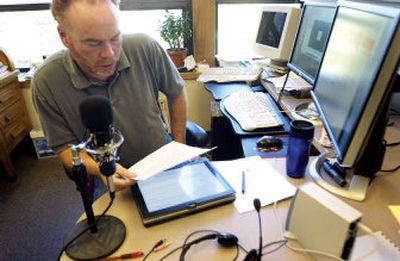High-tech chem class

BUTTE – In his office at Montana Tech, chemistry professor David Hobbs hunches over a microphone and explains a problem he is writing on his tablet computer.
But most of the time, no one is listening – at least not yet.
Hobbs is using computers, audio and video programs and old-fashioned imagination to produce more ways to communicate and engage his freshman chemistry students in the subject. He is also using a language – technology – that they understand better than many older adults.
Some of Hobbs’ efforts produce what are known as podcasts, which are media files that can be played on a computer, iPod or other player. Complete with graphics, music and explanations supplied by Hobbs, students can view narrated mini-movies or tackle a tough chemistry problem whenever or wherever they like.
“It’s really changed my energy in the classroom,” Hobbs said. “And students seem more engaged.” Using podcasts, screencasts, e-mail and interaction with Hobbs’ personal chemistry blog, students can access more information from chemistry students and professors all over the world, and communicate with Hobbs better than ever before.
Hobbs believes the use of the media to supplement classroom instruction helps. Students can get immediate feedback on their work or seek more information, and it fires them up about science.
“I only see them three times a week,” he noted, saying that the class moves fast, and it’s important that students master concepts before moving on to new ones.
And with Hobbs’ blog – which is an Internet-based place where people can exchange ideas and have conversations on the Web – students can post comments and questions, or even throw in a chemistry joke or two.
“He is attempting to contact with and talk to students in their own language,” said department head Doug Coe about Hobbs’ new efforts.
“Students have grown up with iPods and have operated computers from when they are little. They operate in a different world,” Coe said.
Hobbs’ decision to try a new approach with students was born during a sabbatical last year. A professor for nine years, he was fearful of going back to a classroom to teach the same things the same way.
But the blogs, podcasts and screencasts come with a price: Hobbs estimates he spends about 15 hours a week creating material for students to download, view or respond.
“This is so different from when I went to college,” Hobbs said. “And it really changes the way you think about teaching.”
But it is also something Hobbs loves to do, going so far as to write and edit scripts to accompany podcasts and pick appropriate music such as Bob Dylan, or the song “Cool, Clear Water” to adorn his podcast on “Water: The Movie.” which carries the disclaimer that no water molecules were hurt during filming of the movie.
Hobbs believes that the changes are paying off, at least in interactions with students and what may or may not be working as they are learning. “It helps me understand what they are not understanding,” he said.
He also believes the use of technology he favors will spread, envisioning the day when college campuses will include a studio for professors to produce podcasts, screencasts and more.
“We thought it was exciting,” Coe said of Hobbs’ new ideas. He added that all students learn differently, while some may respond better to traditional stand-up-and-lecture teaching, others may favor hands-on, interactive approaches.
With the media produced by Hobbs, it gives students the best of both worlds.
“It’s a pretty challenging subject,” Coe said of chemistry. “And this kind of enthusiasm helps.”